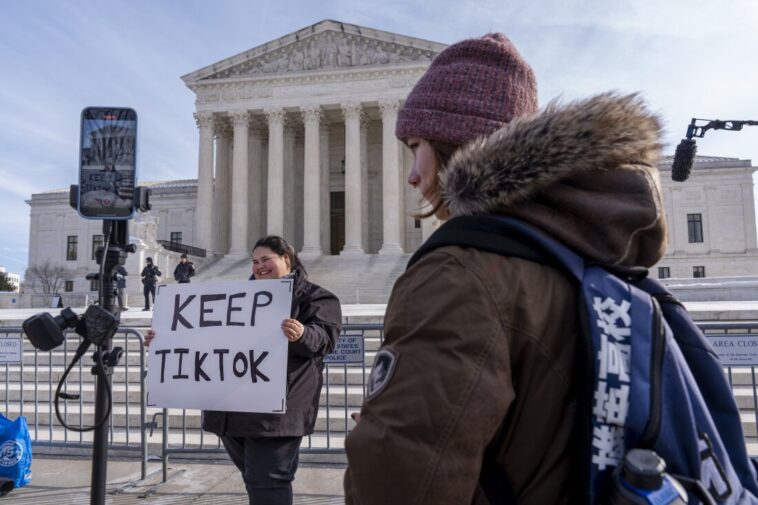
Legal overview of the TikTok ban
In a precedent-setting decision, the Supreme Court upheld a law banning TikTok unless sold by its Chinese parent company. This judgment sparked far-reaching debate and set significant legal precedent. The ruling should be deliberated in the scope of digital rights, economic sovereignty and global trade politics.
Legal Interpretation of Digital Rights
Maintaining the balance between digital rights and national security is a challenge for any democratic society. The judgment brings these issues to the forefront like never before. Digital rights advocates argue the ban infringes on freedom of expression and digital privacy laws, while proponents for national security prioritize protecting the nation from potential cyber threats. Analyzing the Supreme Court’s ruling involves dissecting these key legal perspectives.
Understanding Economic Sovereignty
The edict also raises questions of economic sovereignty. The increased scrutiny on overseas-owned applications highlights concerns about the potential misuse of user data for foreign advantage. Because of this, the legal landscape is shifting towards more regulatory power to monitor and control foreign investments. The TikTok ruling underscores the need for enhanced laws protecting economic interests without suppressing global digitization.
Repercussions on Global Trade Politics
The TikTok case is also a significant touchstone in global trade politics. Amid escalating trade tensions, the ruling could impact future diplomatic relationships and international trade agreements. The legal implications of the ruling extend beyond the United States and China, affecting how digital trade regulations are structured worldwide. It is a call to redefine the legal framework for global digital commerce, honoring both national security and digital rights.
The Rise in Violence in Phoenix
In poised contrast to the technological issues that dominate headlines, the local criminal scenario in Phoenix also requires extensive legal analysis. The recent uptick in violence in the city raises legal and ethical questions about community safety, law enforcement, and the criminal justice system.
Understanding the Legal Framework
Several high-profile crimes, including murders and fatal attacks, have been reported in Phoenix in recent months. These troubling incidents prompt a review of the legal parameters of community safety, the effectiveness of current laws, and the adequacy of law enforcement efforts. The criminal justice system’s lens is crucial for evaluating these rising crime rates and proposing legal reforms as viable solutions.
Law Enforcement Response
Analysts have drawn attention to the way the law enforcement bodies respond to these incidents. There’s an ongoing debate over the police’s ability to maintain order and their accountability in such distressing times. This discussion allows us to scrutinize law enforcement procedures, policies, and training, offering a comprehensive understanding of the law enforcement responses to violent crimes.
Legal Remedies and Reform
Considering the alarming violence rates, an urgent call for legal remedies and reforms echoes from both the community and legal experts for a more effective system of crime prevention and better support for victims and witnesses. The legal system must constantly evolve to better serve the needs of society, addressing the causes and consequences of crime from a humanitarian perspective as well as a legal one.
Carbon Monoxide Tragedy and Legal Responsibilities
The recent tragic incident of carbon monoxide poisoning at Saguaro Lake, resulting in three fatalities, underscores the urgent need to evaluate legal responsibilities and public safety regulations related to such hazards.
Public Safety Regulations
The incident raises questions about the current public safety regulations and their adequacy in preventing such tragic events. It warrants an in-depth examination of existing laws related to the maintenance of public spaces, especially those prone to carbon monoxide exposure. There’s an immediate need for stricter regulations and precautions to protect the public from a silent killer like carbon monoxide.
Legal Responsibilities
Understanding who can be held legally accountable in such tragedies is crucial. Whether the responsibility lies with facility managers, public agencies, or individuals hinges on specific legal interpretations. Analyzing current laws and legal precedents related to carbon monoxide incidents offers a more comprehensive understanding of the responsibilities and liabilities in such cases.
Potential Legal Reforms
Lastly, the tragic event also signals the need for legal reform. There is a pressing demand for stronger laws that focus on prevention, timely response, and accountability in cases of carbon monoxide poisoning. It’s time for the legal system to reassess, and possibly redefine, the liabilities and actions in response to such public safety threats.
Originally Post From https://www.azfamily.com/video/2025/01/17/supreme-court-upholds-law-banning-tiktok-if-not-sold-by-chinese-parent-company/
Read more about this topic at
Arizona Digest
Arizona News Digest (Phoenix, Ariz.) 1964-1967


